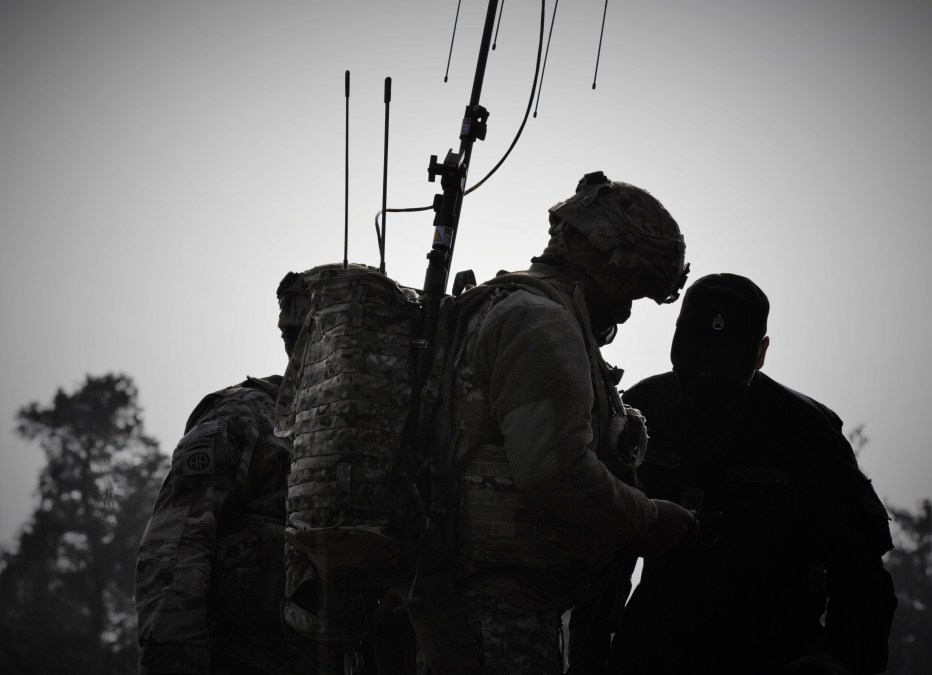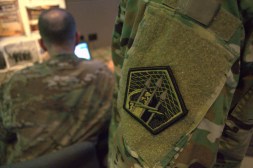Could US Cyber Command play a larger role in electronic warfare in the future?

Cyberspace and electronic warfare are very closely linked. The former is considered by the Department of Defense to be a full-fledged “domain” of warfare while the latter is not, much to the chagrin of its impassioned EW community. While cyber has a dedicated combatant command, electronic warfare is merely a functional area under the combatant commands.
Authorities to launch cyber effects have traditionally been held at the highest levels of government, while electronic warfare capabilities have been held at much lower levels on the battlefield.
While U.S. Cyber Command conducts and coordinates the offensive cyber operations at the strategic and operational levels, there has been a blending of sorts among organizations at the tactical level.
However, for the time being, it seems, Cybercom is leaving EW operations — and the closely related radio frequency-enabled cyber operations — to the services to conduct.
“Traditionally, the services had electronic warfare capabilities that they deployed with their forces … It is not part of my command. But again, a lot of the electronic warfare done is done in support of service requirements. They have service forces that do this,” Gen. Paul Nakasone, commander of Cybercom, told the Senate Armed Services Committee in March when asked about the relationship between EW and cyber and who is in charge of coordinating EW.
The worry, at least for one senator, is duplication of effort and how these effects will be coordinated and synchronized.
“I’m concerned that if electronic warfare is scattered among the services, it’s not going to have the attention, for example, that cyber has, because we have Cyber Command. And electronic warfare is definitely going to be part of the conflict whether it’s jamming or disabling satellite communications, those kinds of things. What you’re telling me is … it’s not part of your command and there’s no central command that controls it?” Sen. Angus King, I-Maine, asked Nakasone. “I worry about coordination and duplication, two sides of the same coin.”
Nakasone explained that Cybercom is now beginning to work closely with the other combatant commands regarding synchronization of the battlefield, noting “much in the same way we have tactical forces that assist the services, is there some type of national capability that we might need? And I think that’s something that we have to look very carefully at.”
Following Nakasone’s remarks, Cyber Command declined to offer greater detail regarding its role in electronic warfare, stating through a spokesperson that “the services have electronic warfare capabilities that deploys with their forces. Beyond that, there is no additional context to provide at this time.”
Cybercom has traditionally been focused on strategic, IP-based networks and targets from remote locations. However, as cyber and the electromagnetic spectrum have grown in importance — due to the preponderance of technologies and the sophistication of the threats the U.S. finds itself facing — there has been a convergence of sorts that has taken off at the tactical level.
Some services, namely the Army, but the Marine Corps as well, have developed tactically focused forces to exploit these capabilities, primarily through what are known as radio-frequency effects. These are essentially cyber effects that exploit WiFi or other wireless electronic systems using proximal or close access forces.
Additionally, as military targets are becoming harder to hack into, the Defense Department and the services are looking to combine cyber and electromagnetic effects to gain access to adversaries’ systems through radio-frequency means.
As these capabilities and forces mature, it is expected that these proximal forces could actually gain accesses and pass that off to high-end Cybercom operators remotely to exploit.
Before cyberspace emerged as a warfighting domain, the DOD had already developed an electronic warfare arsenal.
“Before we even thought about cyber, we had EW capabilities. However, due to the realities of digital convergence we need to rethink our approach to how we develop, test and execute these capabilities — as well as the policy and authorities frameworks that allow them to be utilized in a synchronized and integrated manner,” Charles Moore, the former deputy commander of Cybercom, told DefenseScoop.
“As we have developed our understanding of the cyber domain and cyberspace operations, it became obvious that there is a ‘duality’ to the domain … It’s a conduit for information that enables traditional warfighting capabilities and it’s a warfighting domain where you can achieve effects in and of itself. It’s both things simultaneously. You have to understand this to capture cyberspace’s full potential. Very little of what we traditionally call EW does not rely on the cyber/digital domain,” he added.
The separation of these capabilities from an organizational standpoint has made sense given electronic warfare is done at the very local level while these cyber operations are done remotely, according to Bryan Clark, senior fellow and director of the Center for Defense Concepts and Technology at the Hudson Institute.
But, from a programmatic level, it is really problematic.
“Electronic warfare hasn’t gotten a lot of attention and priority from DOD over the last decade … DOD has not really fundamentally improved its ability to fight on offense, to go on offense in the electromagnetic spectrum. Whereas China and Russia have both improved their own capability,” Clark told DefenseScoop. “I think if you had a champion, like a Cyber Command, to advocate for electronic warfare, the DOD might get better at it. I think we’ve seen with cyber that the fact that Cyber Command is a one-stop shop for cyber capabilities makes them also a really strong voice in advocating for those programs. Whereas with the DOD, it’s all diffuse for electronic warfare. It’s hard for electronic warfare capabilities to get the same level of priority.”
The Pentagon hasn’t fully wrapped its arms around the notion of digital convergence yet, which has led to this stove-piping of capabilities, otherwise there would have been a much different and integrated approach to these capabilities, observers say.
“We wouldn’t still be stove-piping them and looking at them with different policy frameworks, different authorities, and different organizations within the department. We have to have a more holistic and strategic approach,” Moore said.
Clark added that given the divestiture of offensive electronic warfare capabilities across the services after the Cold War — such as jammers for electronic attack — most of the offense in the spectrum now involves cyber.
“Essentially, we’re using the spectrum as an alternative path to get into other people’s networks. That’s actually how offensive operations in the spectrum are done at this point,” he said.
“I think the DOD EW community would be well served by leveraging that and saying, ‘Here’s how we go on offense: we use cyber, we need to be thought of as another arm, basically, of Cyber Command.’ And Cyber Command should embrace that because [in] a lot of cases, opponents have gotten smart. They’ve firewalled their networks off so that Cyber Command can’t reach them from [its headquarters in Maryland at] Fort Meade because they have a standalone network that’s not connected to the internet,” Clark continued. “Cybercom is having to increasingly rely on these RF-enabled systems to actually get access to other people’s network. It would be probably good for both communities to be more open about this as being the way ahead.”
Others have noted that there have been discussions within the Pentagon regarding putting electronic warfare under Cybercom.
Congress has begun to take note of this convergence trend as well. In the most recent annual defense policy bill, Congress is requiring the Department of Defense to develop a strategy for “converged cyber and electronic warfare conducted by and through deployed military and intelligence assets operating in the radio frequency domain to provide strategic, operational and tactical effects in support of combatant commanders.”
These “service retained” forces are a distinction from the cyber mission force, which each service presents to and is owned by Cybercom, congressional language notes.
“Through detailed oversight of the committee, a gap was determined in the operational strategies for fielding emerging RF-enabled cyber capabilities,” James Inhofe, who at the time of the legislation was the ranking member of the Senate Armed Services Committee, said last year. “This provision is intended to ensure that the leadership of the department, combatant commands, and military services mature the strategy and capability development processes for these emerging capabilities.”
Cybercom has invested in electronic warfare capabilities for years. In its fiscal 2024 budget request, it asked for $65.4 million for research-and-development funds that go toward adapting electronic warfare technology and cyber-peculiar capabilities to gain access to target enemy forces.
This particular project will “enhance the open source Open CPI framework that will allow the services and USCYBERCOM to develop Title 10 off-net effects,” the budget documents state, referencing the portion of U.S. law pertaining to military operations.






